Masha Kontchakova & Emma Brante,
Creative directors & founders at Frontline Studio
La Chambre entrusted Emma et Masha with the creation of their global branding. The both worked closely on storytelling, visual identity, web design and photography to position the brand in a competitive e-commerce market.
What was the starting point for this project ?
Alison and Ian came to us with an idea for an e-commerce business that wanted to offer an excellent quality sheets at affordable prices. The original slogan was even considered: “Why should we wait for the sales?
It was our first e-commerce brand and also the first brand that has being created with us. It was very exciting to work from scratch on a concept that is very defined and rooted in French culture. We proposed from the start to change the initial brand name that we found too complicated and came up with a simple name with a very direct connotation, which is La Chambre (room in French). This word had the advantage of being easily remembered and above all opened a very wide field for communication. That was our starting point.
How did your collaboration with Alison Ross and Ian Benton, the founders of the brand, happen?
It was an 8-handed collaboration. I don’t think we’ve ever had so much coffee with a client! We see each other 2-3 times a week. It was intense and creative.
Also, we love working with foreigners as we are of foreign origin ourselves. Alison is American, Ian – British, we like this mix of cultural references.
What were your inspirations at the very beginning of the project and how has it evolved during its development?
Alison and Ian wanted a very French brand, rooted in French culture, with the idea of one day exporting it abroad. So our inspiration was France. We wanted to bring a vintage feel to the French countryside, so we immersed ourselves in the textiles of our grandmothers: the linen cloths with red lines, cross-stitching red lines, ribbons, buttons, stamps…
All of this is transcribed today in a rich graphic universe: the main logo with its characteristic red line, which recalls the linen towels but also the Hausmanian mouldings. This red line has become a leitmotif that runs through the entire graphic universe.
The second complementary logo is drawn more like a button with the points in a cross. And the design of the labels is conceived as a stamp that would be affixed directly to the fabric, as it was done at the time in laundries and dry cleaners.
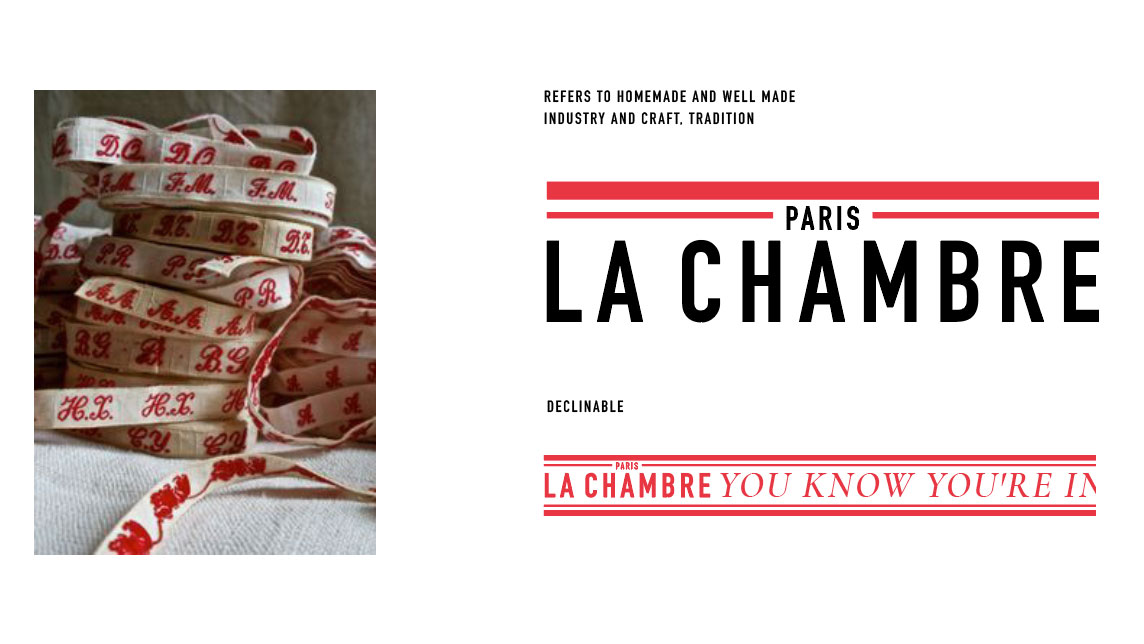
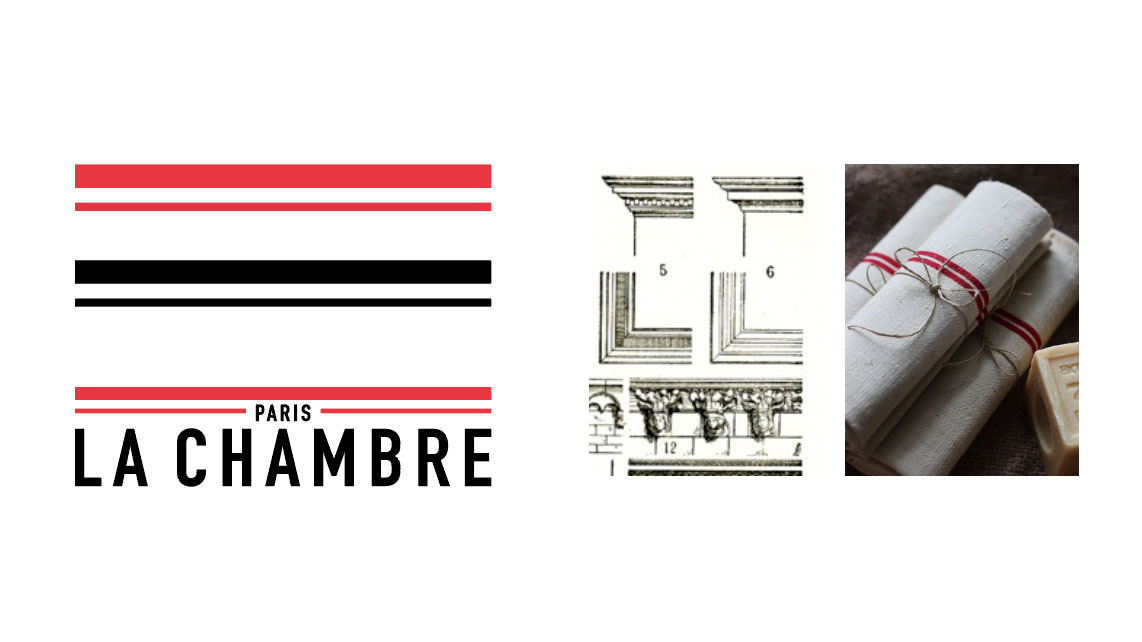
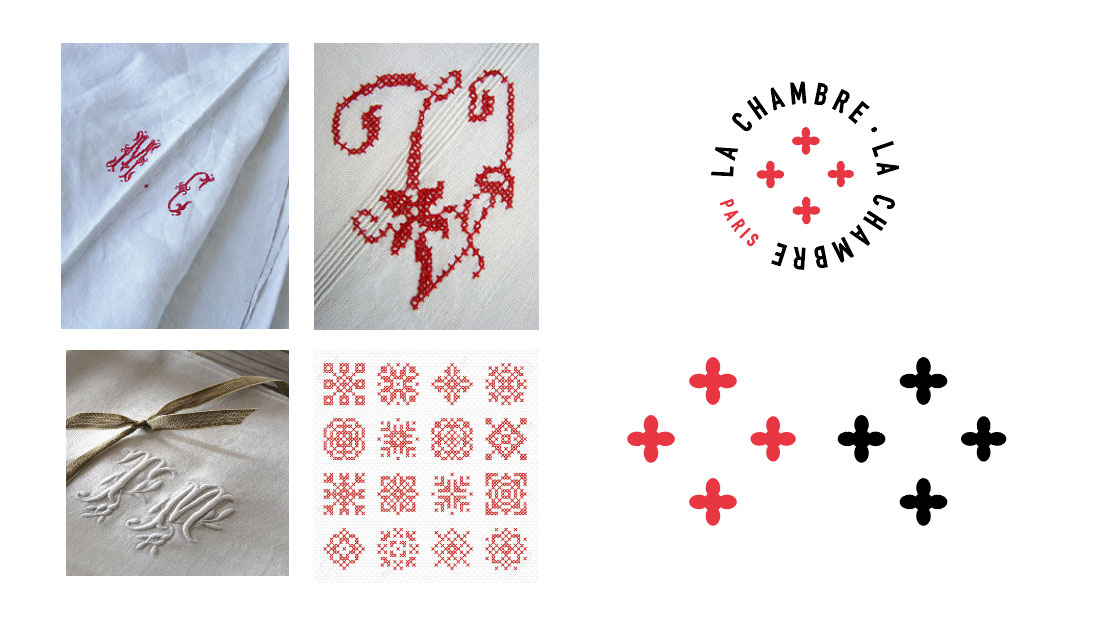
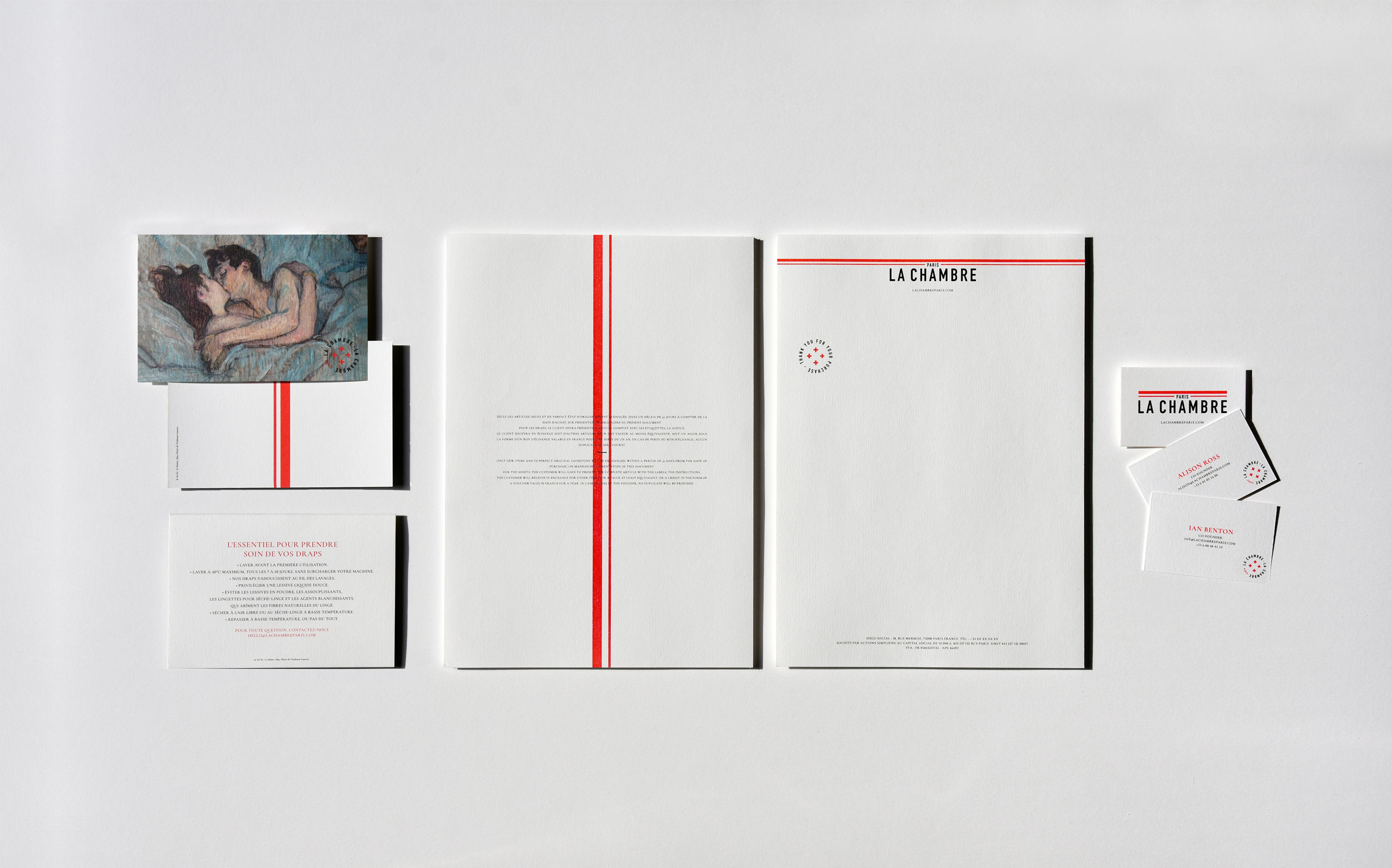
You also did the art direction and produced the photographs for La Chambre Paris. What were the main challenges in creating these images?
Photography was very important in this project, because the only sales channel for the brand is the web. It was necessary through the screen not only to attract but also to make people feel the material, its quality and its texture.
We had two directions – the first was to immerse the customer directly in the bed! We worked on the sleek, nonchalant yet sophisticated design and the natural light which gave the beautiful part to the material. We also chose the timeless environment – contemporary but devoid of any reference. This allowed the client to easily project themselves and imagine these sheets in their own home.
The second direction was the inspiration of the Nabi and French painters of the late nineteenth century, such as Bonnard, Vallotton, Toulouse-Lautrec who painted the interiors and the everyday environment. This gave rise to some photos and especially a communication axis for social networks.
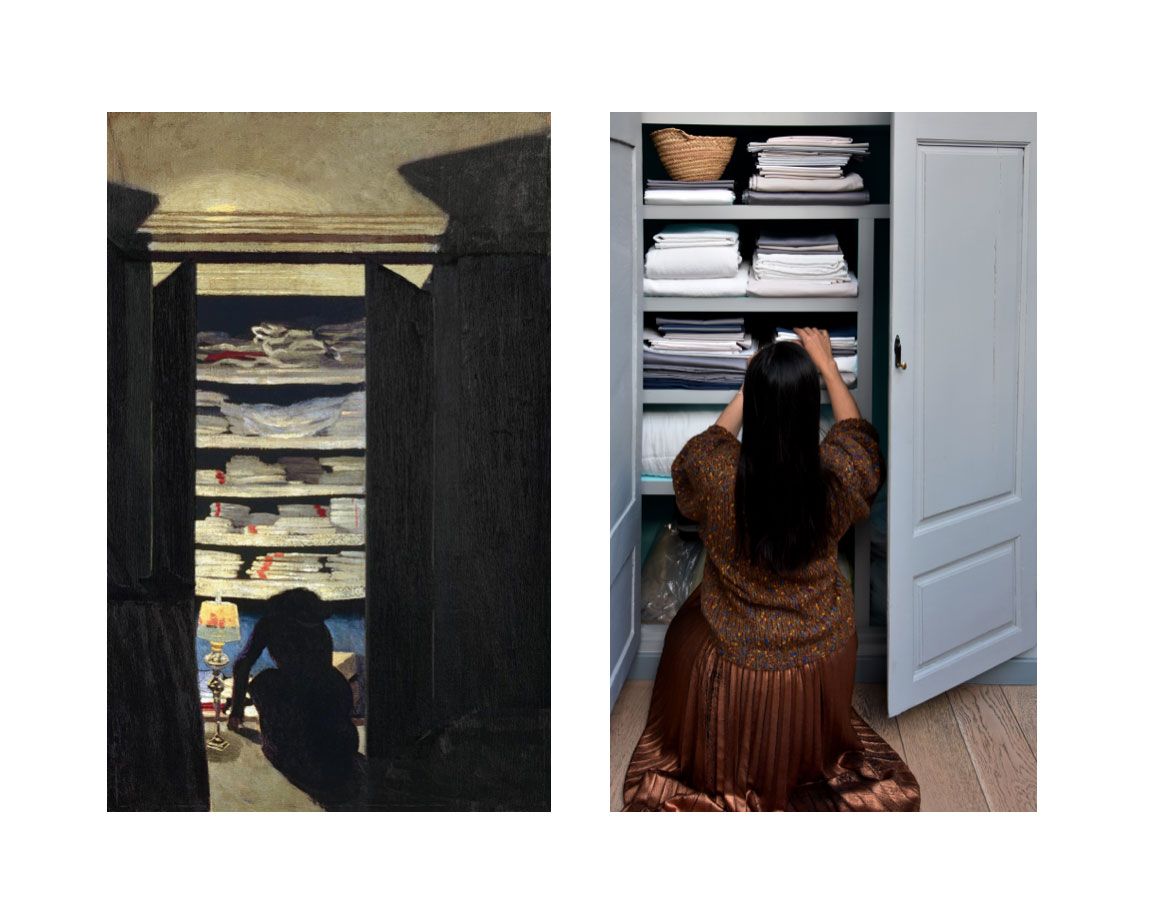
What are the other particularities of photography for e-commerce?
In addition to inspiration photos, there is also the challenge of presenting the products themselves. We worked on the artistic direction of the packshots. How do you “package pack well”? We relied on a very rigorous and graphic presentation that which allows us to play with lines and colors.
In terms of e-commerce, what were the key points for creating an effective user experience?
At Frontline Studio we believe that the more digital we become, the more relationship with the customer must be personalized and meticulous. That’s why we put a lot of emphasis on the moment the customer receives the sheets: the packaging, the little card, the bags that protect the sheets, all these elements create a mini event and delight the customer. It’s in moments like this that the relationship of affection is created with the brand.
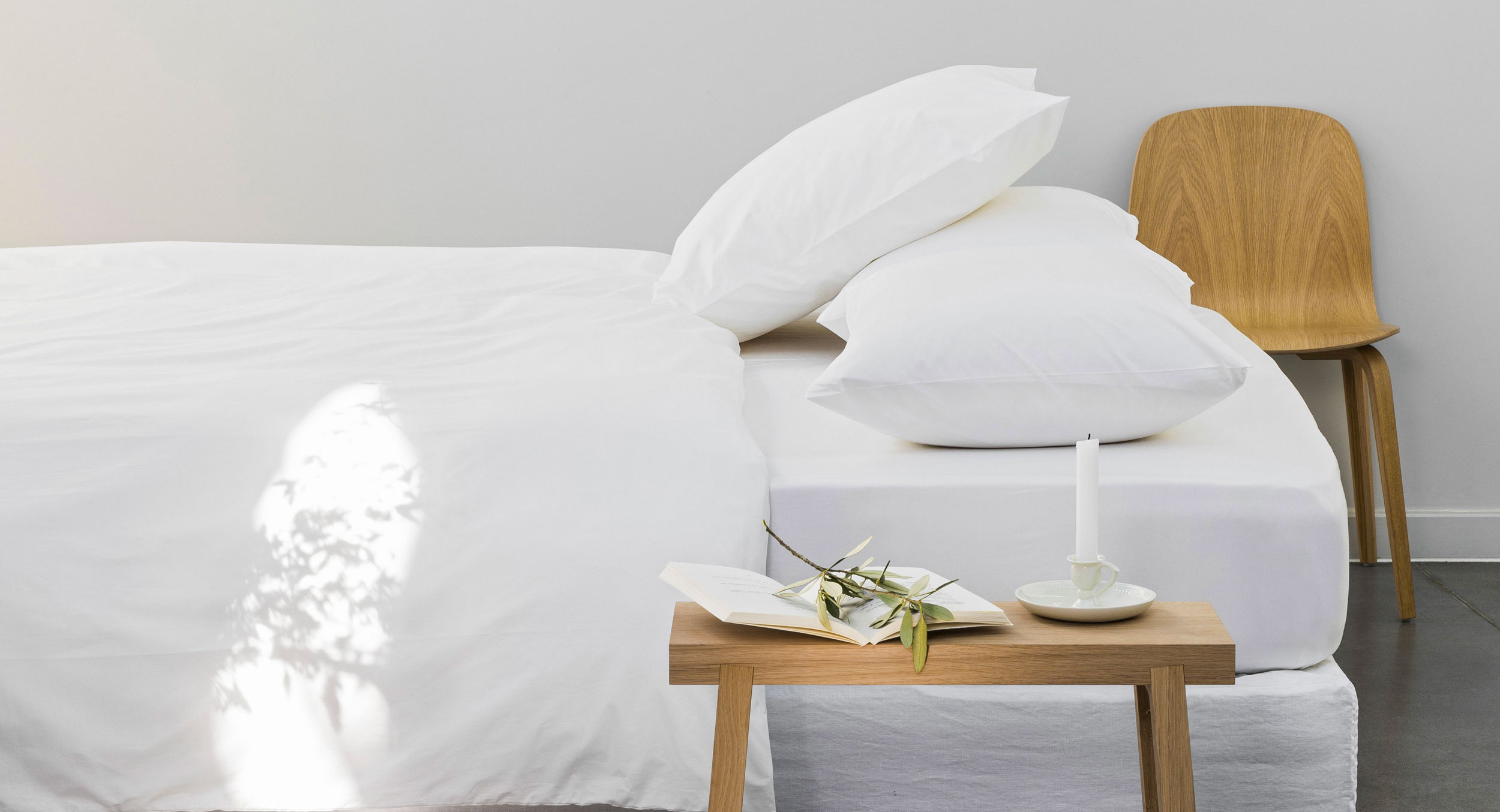
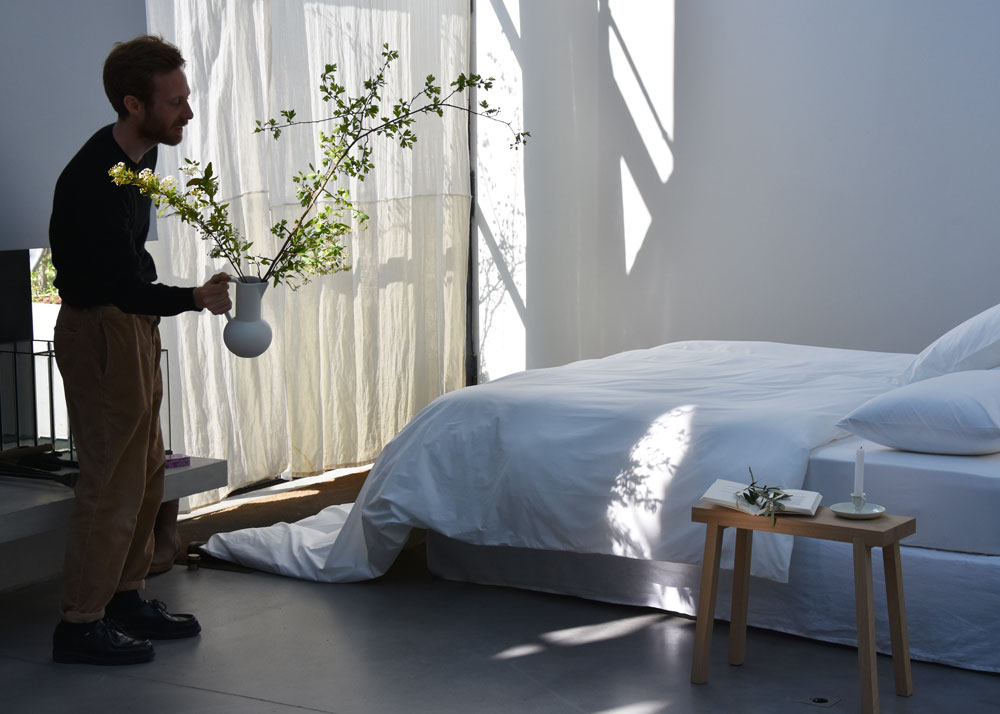
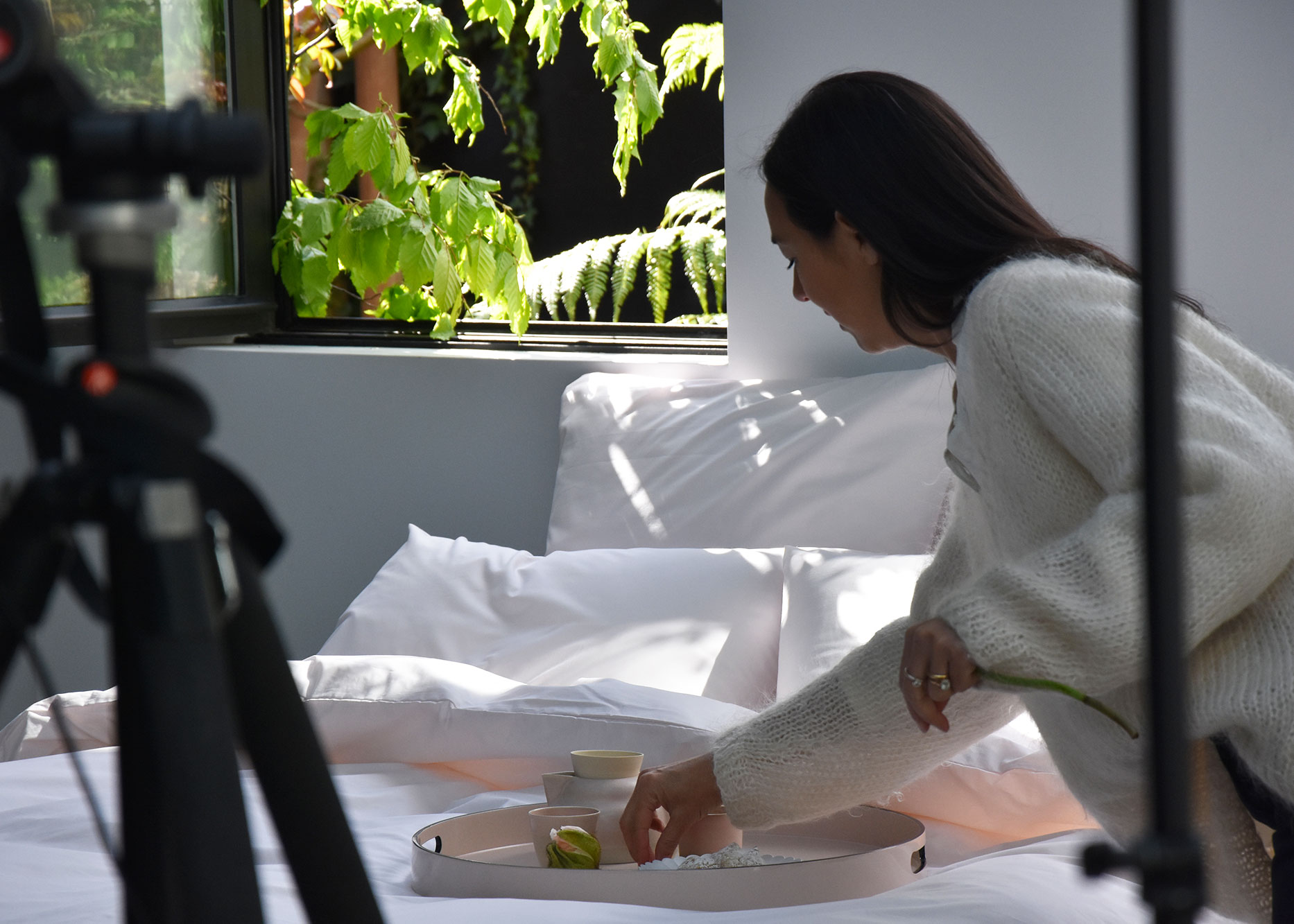
How did you manage to create a strong and recognizable brand identity in such a competitive industry?
We tried to create an identity that was as rich as possible by injecting several ideas and several cultural references.
How would you describe Chambre Paris’ identity in one sentence?
It’s an identity that confirms people’s image of a quality product with traditional French charm.
Discover the whole project La Chambre here.
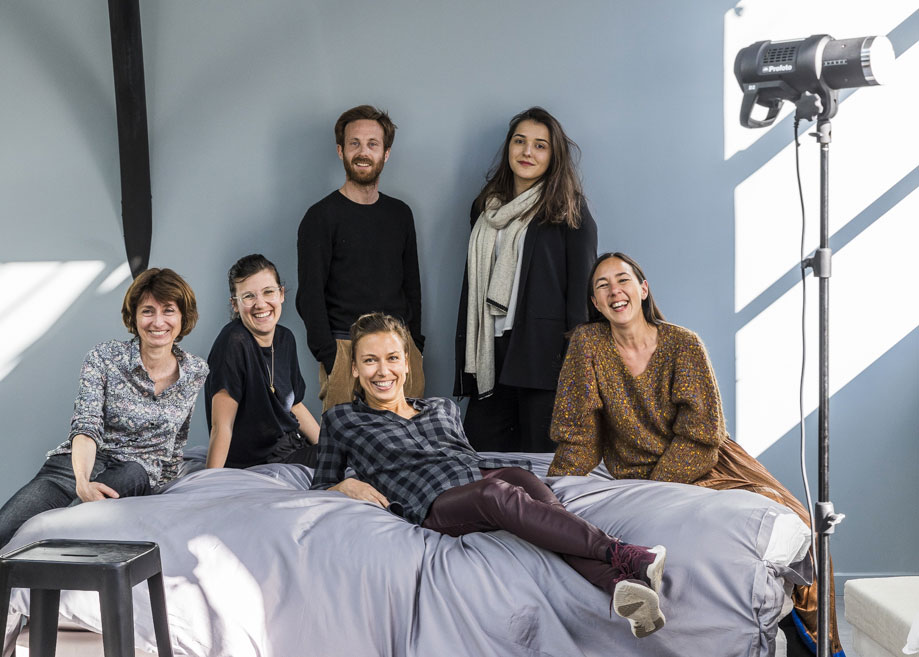
Emma Brante,
Creative Director, Graphic Designer
Founder, Partner
Let us tell you a story… The story of our collaboration with the Bollinger group, created in 1829 by the Bollinger champagne House. Between family transmission and cultural heritage, we invite you to discover the backstage of the creation of the brand identity and new corporate website that we imagined for this exceptional group.
What was the starting point of the project for the Bollinger Group?
The starting point was a brief. A brief is a magic box, a mix of « everything is possible » + « beware, you can’t just create anything you want that looks beautiful 🙂 ».
The group had been existing for decades and it was until now a discrete financial holding. As the group was becoming more important, welcoming new Houses, questions appeared internally as well as the desire to exist publicly as a group. Our mission was to create the public image they needed without overshadowing the brands. A visual and editorial line to express their values, the reputation and aura of their brands.
In phase one of our work, we built the identity language of the group: its name, its logo, its slogan and a universe. We continued this work in the same spirit in order to deploy and implement the new vision and identity of the group.
What were your inspirations for the new corporate identity of this independent family-owned group?
A group is the voice of a culture. For the Bollinger Group, we wanted something soft and inspiring – and therefore human – as opposed to a cold financial institutional image. Something that is close to nature.
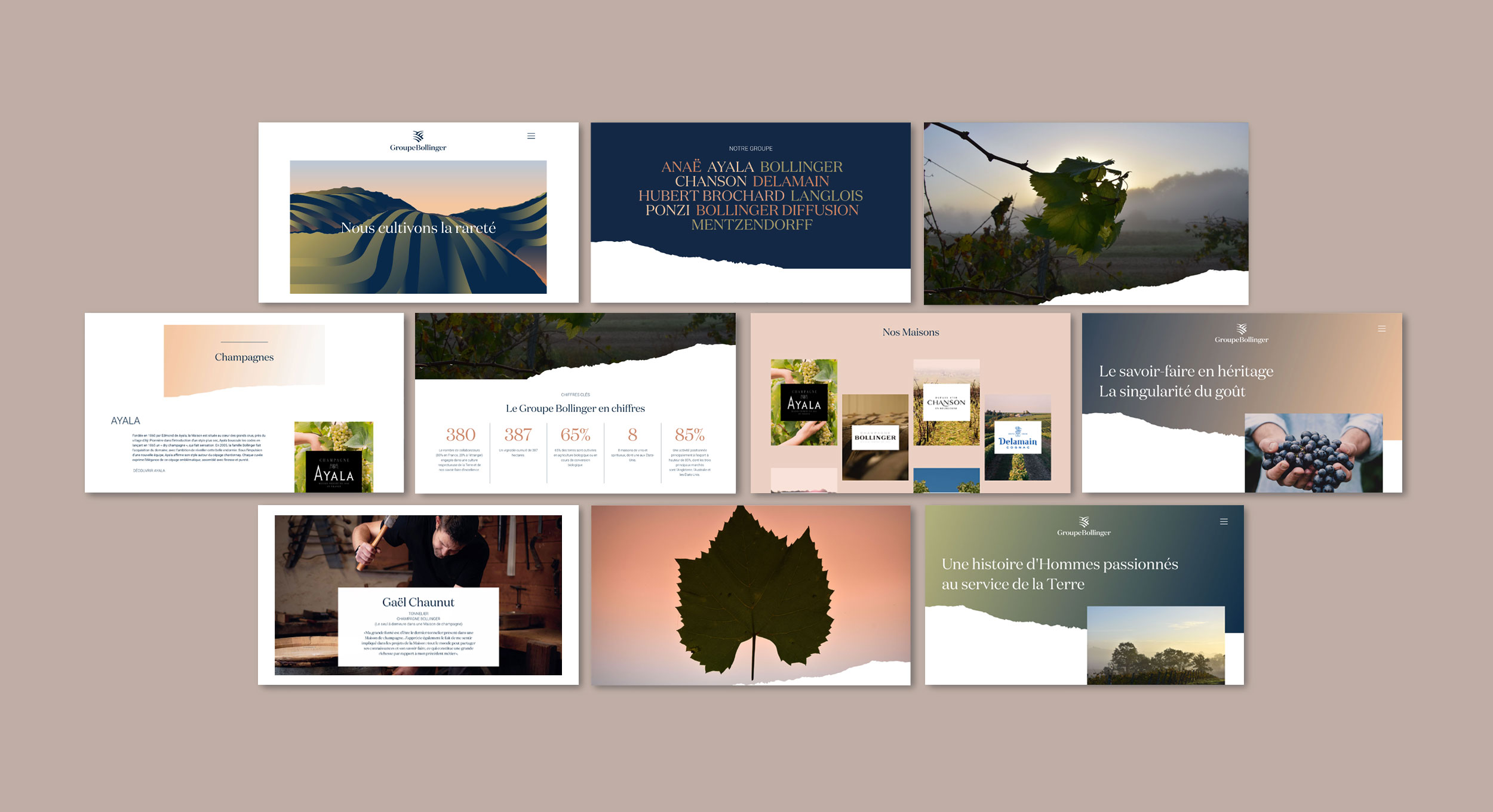
What was the logo design process?
The lines drawn by the cultivated fields, so typical of the vineyards. This was the starting point. This landscape is one of the first images one has in mind when imagining vineyards. The second idea was to find a symbol to represent the historical dimension of these Houses. A character of nobility and belonging. The shape of the logo refers to a shield. And the last idea was to signify the concept of land in the sense of an estate, a property.
This logo is the final association of this landscape in the shape of a blazon.
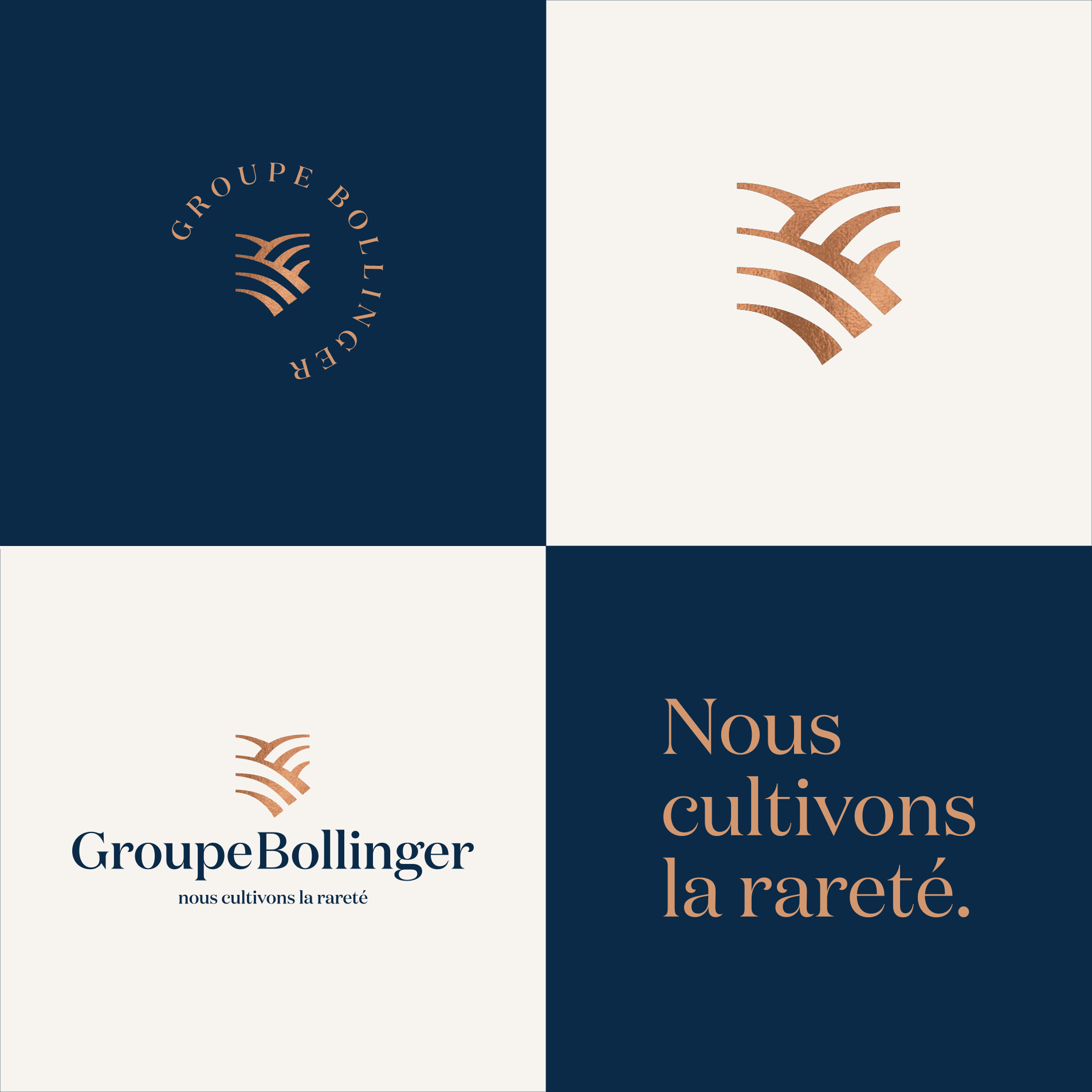
“Cultivating the Rare”: how does this baseline represent the vision and history of the Bollinger Group?
The group had a baseline which was « Families of rare wines ». Having integrated new spirits brands, this phrase no longer represented them. The heart of it was the word « Rare ». And then, associated to the idea of a « culture » and playing on the multiple meaning of this word that carries many rich ideas such as: the idea of an identity, the patrimonies and the cultivation of the land, we created that baseline « Cultivating Rarity ».
This slogan also has an ecological dimension and evokes a respect for the Earth
How did the Bollinger Group website come to life to look like it does today?
A group is not a brand, it’s an institution. As for any serious major institution, the visual grammar must be rich and creative in order to convey a sovereign image. The website revolves around the idea of landscapes and the richness of the land. We created graphic landscapes and designed colored hills with ripped paper.
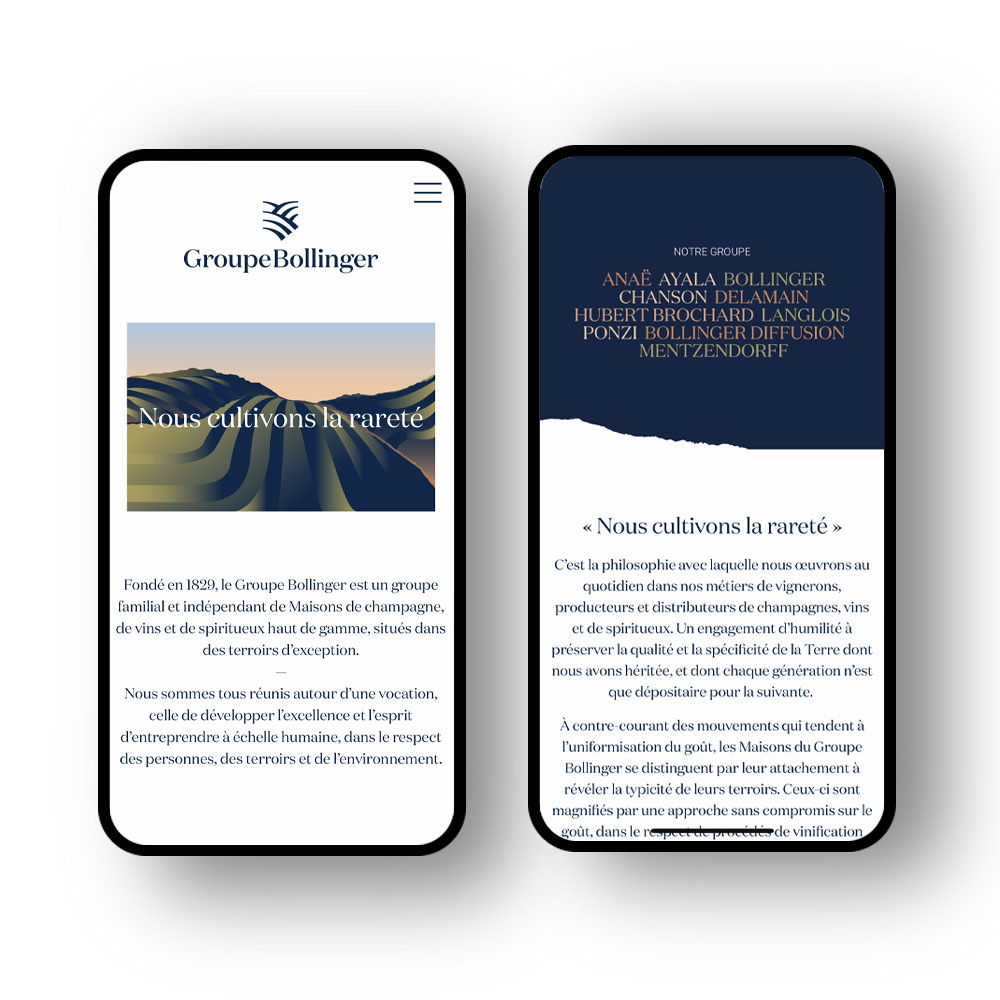
What were the challenges in developing this corporate website?
This website is a flag in the colors of the group’s ambitions and the “extra-ordinary” quality of its Houses.The website allows the Bollinger Group to present itself and address thousands of people at the same time and not just to isolated interlocutors.
Its goal is to shows the foundations of a serious institution and it indirectly generates interest among the Houses. It highlights the brands and entities and can arouse curiosity. The Group’s website makes it possible to say everything that the brands cannot always express.
A photographic coverage was done to illustrate the Bollinger Group corporate website. How would you define the artistic direction of this shooting?
We built the entire identity around landscapes. We had created graphic forms that evoked landscapes playing with colored gradients. The render was a very soft visual feeling.
We shot a series of different landscapes, fields of vineyards. The photos were taken at dawn, bringing to us a mysterious rich light and revealing the magic that only nature can provide.
Each photo is a piece of this nature that carries universal ideas. Swarms of birds, mist invading vineyards, sun rising in the hills, the humidity of the night on the vine leaves. We wanted to recreate the feeling of the scent that the earth has when it is filled with the humidity of the night.
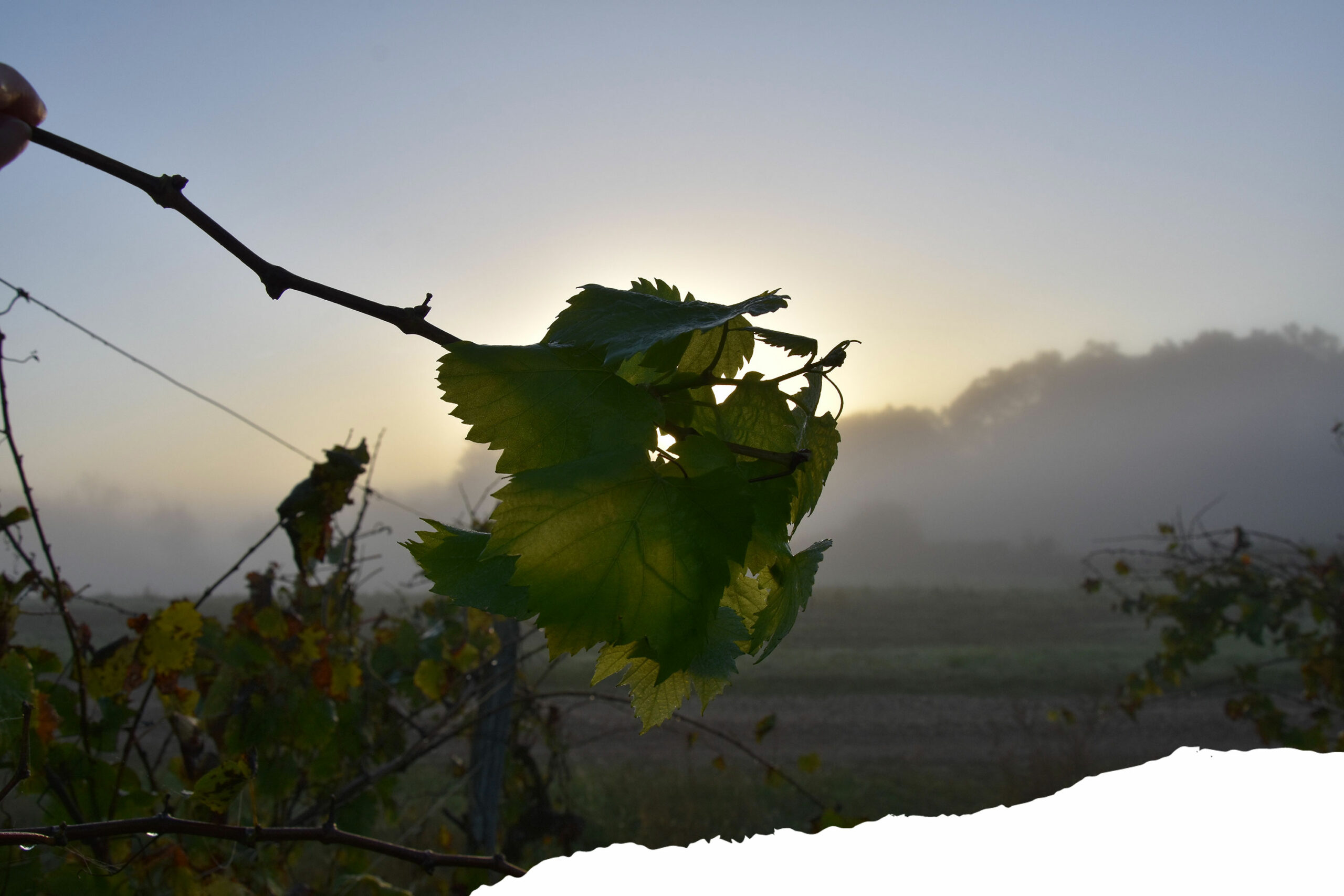
Tell us about the research process to define the iconographic identity of the group?
We have created a series of visuals specific to the group that cannot be confused with those of the brands. The purpose of these images is to give a sense of height and symbolize the group’s unifying role.
Brands mainly broadcast and show product images, we never show products. We have shifted the focus. We talk about the Earth.
How does Frontline establish a brand identity through photography?
It is part of a whole. When we start a project, first we look for a general feeling. It often comes from a first image that we find or that we have in mind. This image evokes a style. From this style we develop a whole visual grammar – graphic, photographic, editorial – that will dress the brand and give it the means to express itself in public.
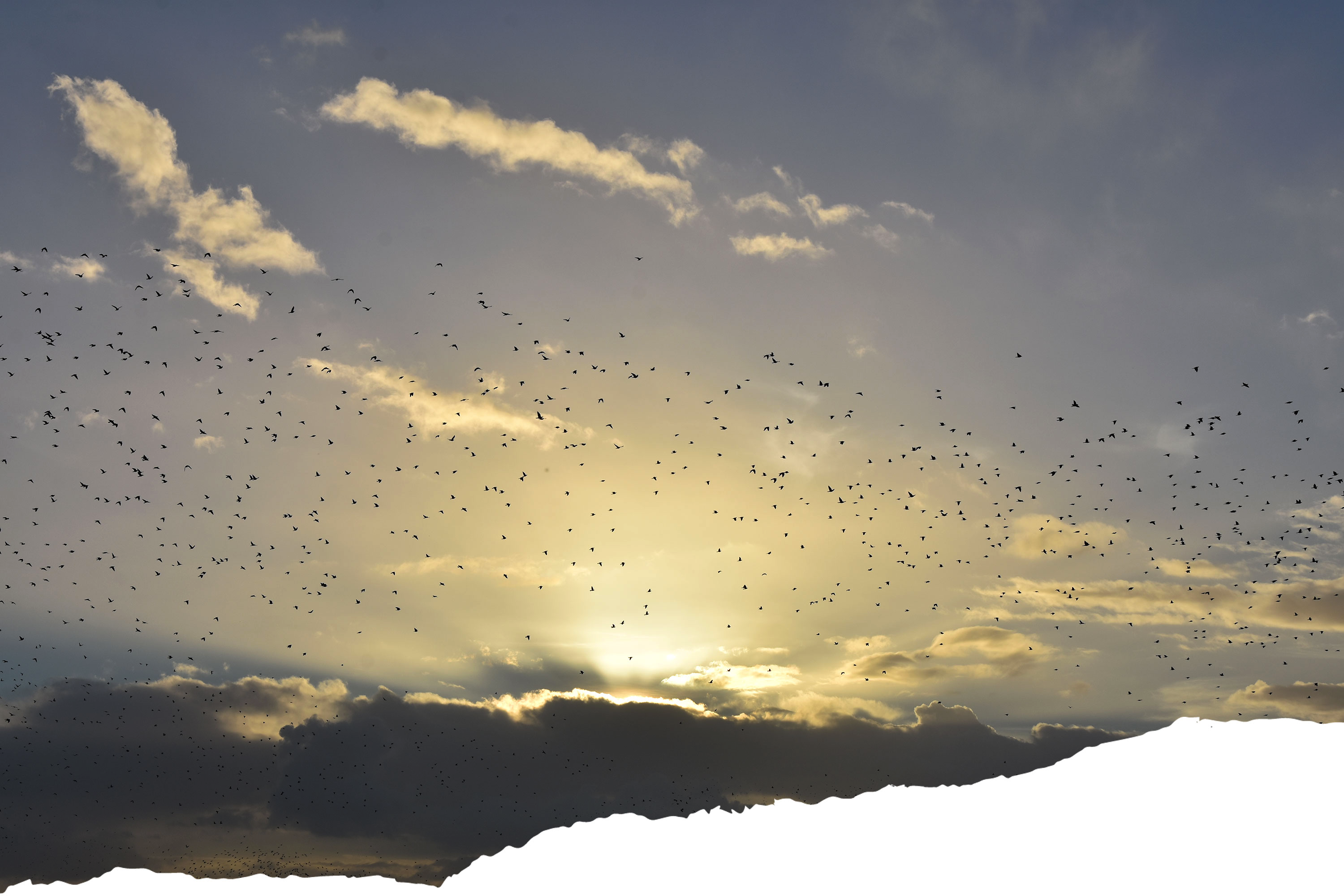
Masha Kontchakova,
Creative director,
& founder at Frontline Studio
Head of communication and creative director of Frontline Studio, Masha Kontchakova puts her sharp eye on brands to help them emerge. For French Bloom, the alcohol-free bubbly wine, she brought her creativity to develop the brand’s art direction through a photo and video campaign.
What inspires you about French Bloom and what were your inspirations for the Art Direction of this project?
French Bloom has developed a non-alcoholic sparkling wine that is a new version of champagne for those who do not wish to drink alcohol. I wanted to find out how this drink is different from others – wine, beer… Champagne by its very nature is a festive drink and above all a drink of celebration. We never drink champagne alone and we drink champagne to celebrate. “Champagne!” – we exclaim when we have won or achieved something important.
So the whole art direction revolved around that – a festive moment of sharing.
What were the different stages in which Frontline was involved? (stylisme, post-production…)
What’s special about Frontline is that we do everything in-house. Every client who comes to us will have only two people to talk to – me and Emma Brante.
On the French Bloom project we handled the entire production of the website, which includes editorial, messaging, text, design, graphic design, art direction, styling, photo production, post-production… bringing together the different talents on the project.
From a marketing standpoint this makes Frontline Studio less readable, less easy to categorize as an advertising company, but we like it that way. We have the pleasure of working on all these posts and in the end the client is always happy to have us because we guarantee the consistency of the art direction.
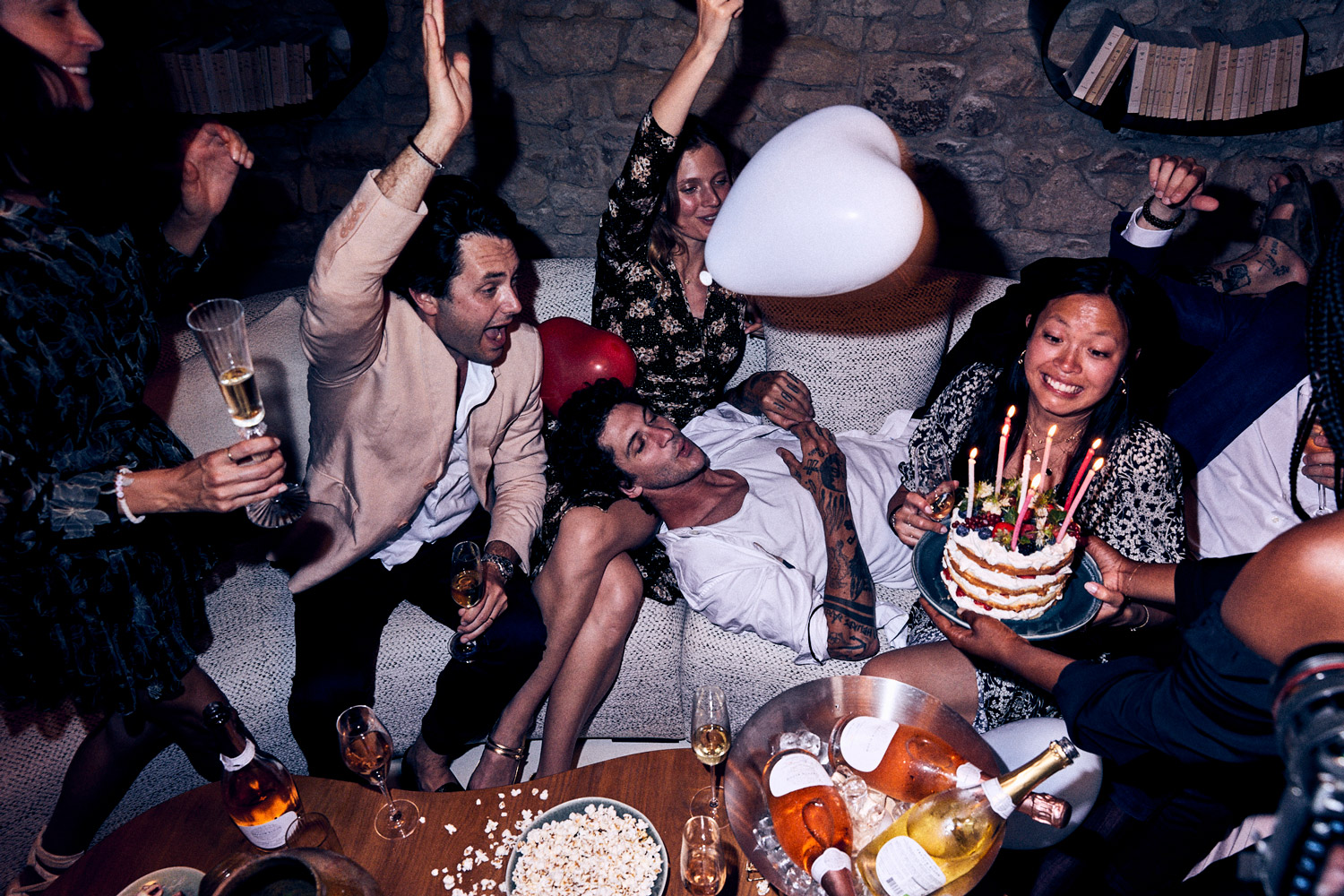
How did you choose the talents you wanted to collaborate with on this project?
I really like Bruce Weber’s group photos and especially his work for the Italian brand Dedon – it’s always the spontaneous moments, caught in the heat of the moment where people are smiling, uninhibited, caught up in the event. I wanted to find this feeling in the photos to be produced.
While strolling in a bookstore, I came across the book “Paris Chic” by Assouline with a superb work by Oliver Pilcher. I loved his look at our capital, I loved the way he captured moments of intimacy and happiness sharing between people. I was completely seduced by his approach.
I contacted him. He happens to live in Costa Rica…. It was not easy to persuade the client to hire a photographer on the other side of the world, when we have so much talent in France. But I succeeded in my bet. I am very happy with this collaboration with Oliver and the result is exactly what we expected!
“French Bloom reinvents moments of happiness and conviviality.” How did you manage to convey this new Art de Vivre through the photo campaign of French Bloom?
I think the most important thing is to take the right tone, here it’s spontaneity, naturalness, good-natured spirit. Then to find the photographer who knows how to capture it – that was really the case with Oliver Pilcher. And then let things happen. You always need a good dose of trust in this kind of production that involves so many people. It’s all about saying that what you want to convey is the only possible direction.
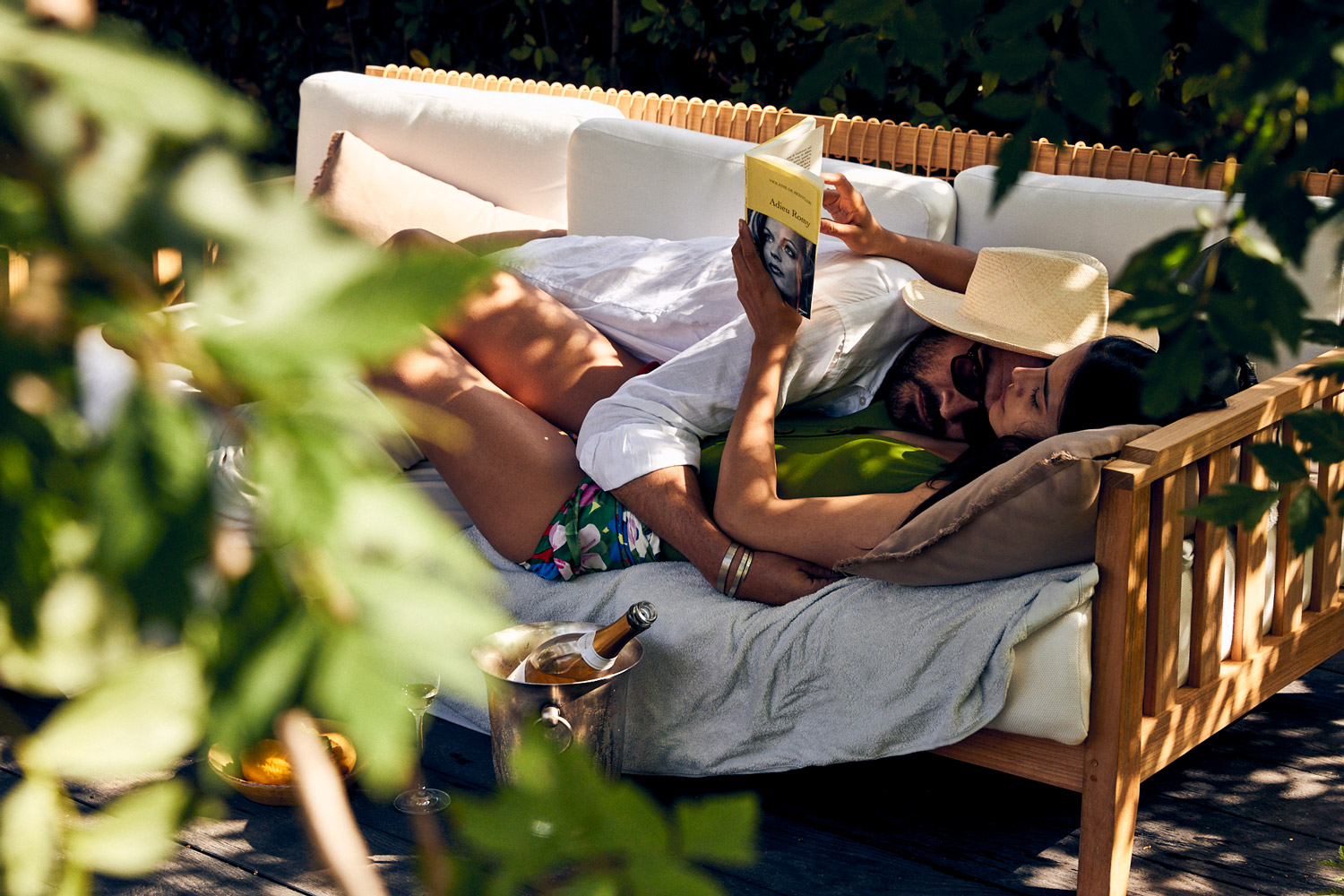
Every project is different, in terms of vision, mood, statement. How does Frontline Studio manage to dive into each of the brands’ universes with which you collaborate?
It’s actually quite easy! A good dose of curiosity and cultural references, and then you let your imagination work!
I have a lot of books and I’ve always loved books, I draw from them – from art, photography, architecture. Most of our projects start with research, I need to capture the essence, to get the real principles on which we can then put our creative eye. The meaning is very important in Frontline studio work.
In addition to the photo shoot, a video campaign was created. How is this type of campaign organized and what were the challenges?
The production of this campaign was a real challenge! We shot in Provence and with 10 people to manage! The production part was very busy – we had to deliver the styling there, scout the day before to find great spots, take care of not only object styling but also clothing styling with its share of surprises at the last moment… We shot from sunrise until late at night.
The biggest challenge was physical: for the end of the video we absolutely wanted an unobstructed view of the Beaux de Provence where the women will meet the sunrise. We climbed mountains, passed through very prickly brush to get to the end of the cliffs, Oliver was barefoot! It was very nice, these are the moments I like the most on the shoot and it was really worth it, because we found an incredible view!
Discover the whole project for French Bloom here.
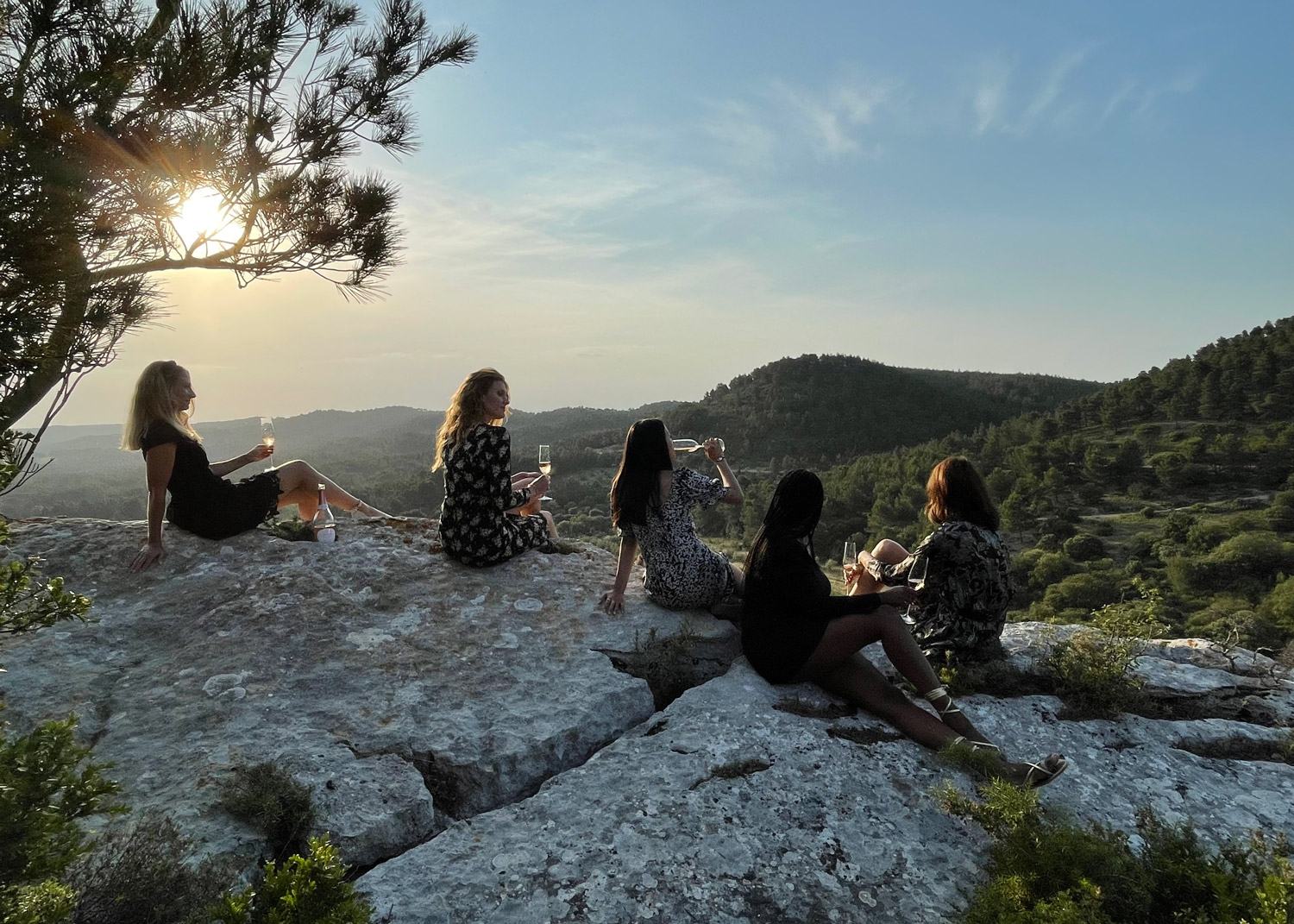
Emma Brante,
Creative director, graphic designer
& founder at Frontline Studio
The French architect Maxime d’Angeac entrusted us with the creation of his visual identity and his entire communication. In this context, Emma Brante, our Artistic Director, conceived the designer’s logo.
I love monograms because I find that typography alone – in the context of a visual communication – is sometimes poor. Of course there are cases where it can work very well, like for Orange Telecom which relies on a color. But I find that a strong emblematic sign fascinates more and marks the minds.
Why did you choose the monogram shape for this logo?
In the context of the graphic identity of the architect Maxime d’Angeac the monogram was perfectly adequate. It has a noble character that comes close to the nature of his work in its aesthetic dimension, his personality, the singular style of his architecture, the luxurious universe of his clients. Finally, the possible play around the particle specific to his name was also a singularity that pushed me to use it and make it a differentiating element.
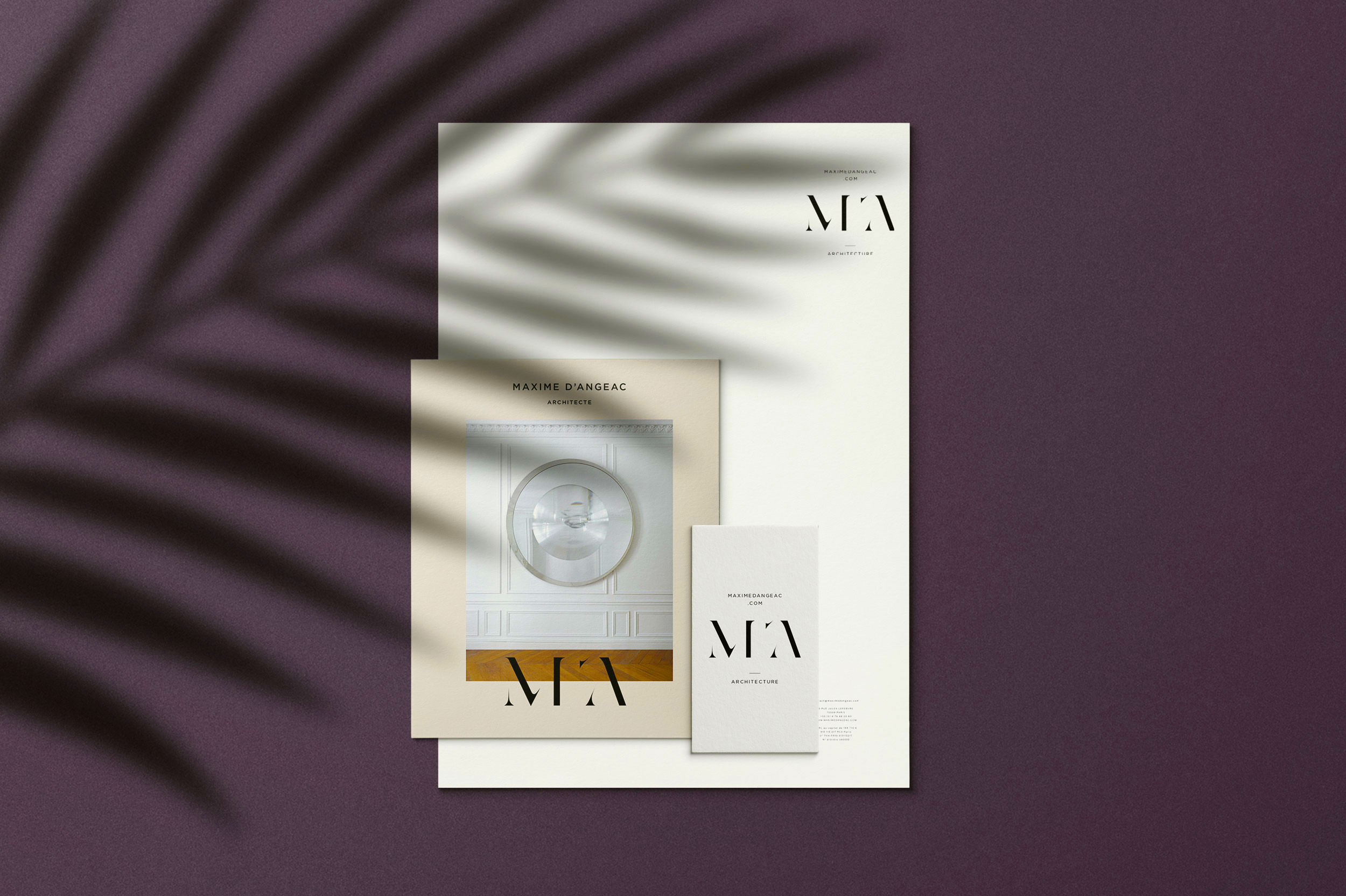
How did you choose the typography?
I drew the letters from a classic typographic structure and then removed certain parts to give the logo a slender character and a contemporary look. In his architecture, Maxime d’Angeac draws on styles from all eras, but he remains an architect who designs contemporary interiors and houses.
How to deal with particles?
There remained to solve the question of the particle its name which moreover is controversial in France. I decided to reduce the particle to the apostrophe alone, giving it a more interesting look than if we had kept the whole thing with the letter D. In the end, it became the strong point of the logo.
Discover the whole project for Maxime d’Angeac here.
Glassdebourg commissioned Frontline-Studio to design a reference brochure for architects. We conceived the brochure’s editorial line, the photography and the graphic design.
How did you define the editorial line of the brochure?
As a specialist in high-end hotel projects, Glassdebourg had to seduce its target audience with a coherent brochure that, without falling into the trap of a catalog of projects, would promote its expertise and the quality of its know-how.
After an analysis of the brand’s DNA, we isolated the term “integration” as the key word at the center of our photographic and editorial work. Integration is the real strength of the company – concrete or brick, marble or corian, each material is “domesticated” by the glass arranged by Glassdebourg.
What was your photographic bias in producing the photos?
With the photographer Fabrice Fouillet, my partner in crime, we produced fifteen photo reports in Parisian hotels decorated by renowned interior designers: Dimore Studio, Tristan Auer, François Champsaur, Sarah Lavoine, Ora Ito… With all these settings, the temptation was to photograph the interiors as a whole, but in doing so, would we be highlighting the work of the studio or rather that of the decorator?
Our approach was to focus our attention on the details and rigor of each project. Some of these photos have also given rise to abstract photographs that emphasize the quality of the materials, the know-how of the workshop and the excellence of the execution. The main goal was to enhance the work of Glassdebourg, even if it meant leaving the functionality of the installations.
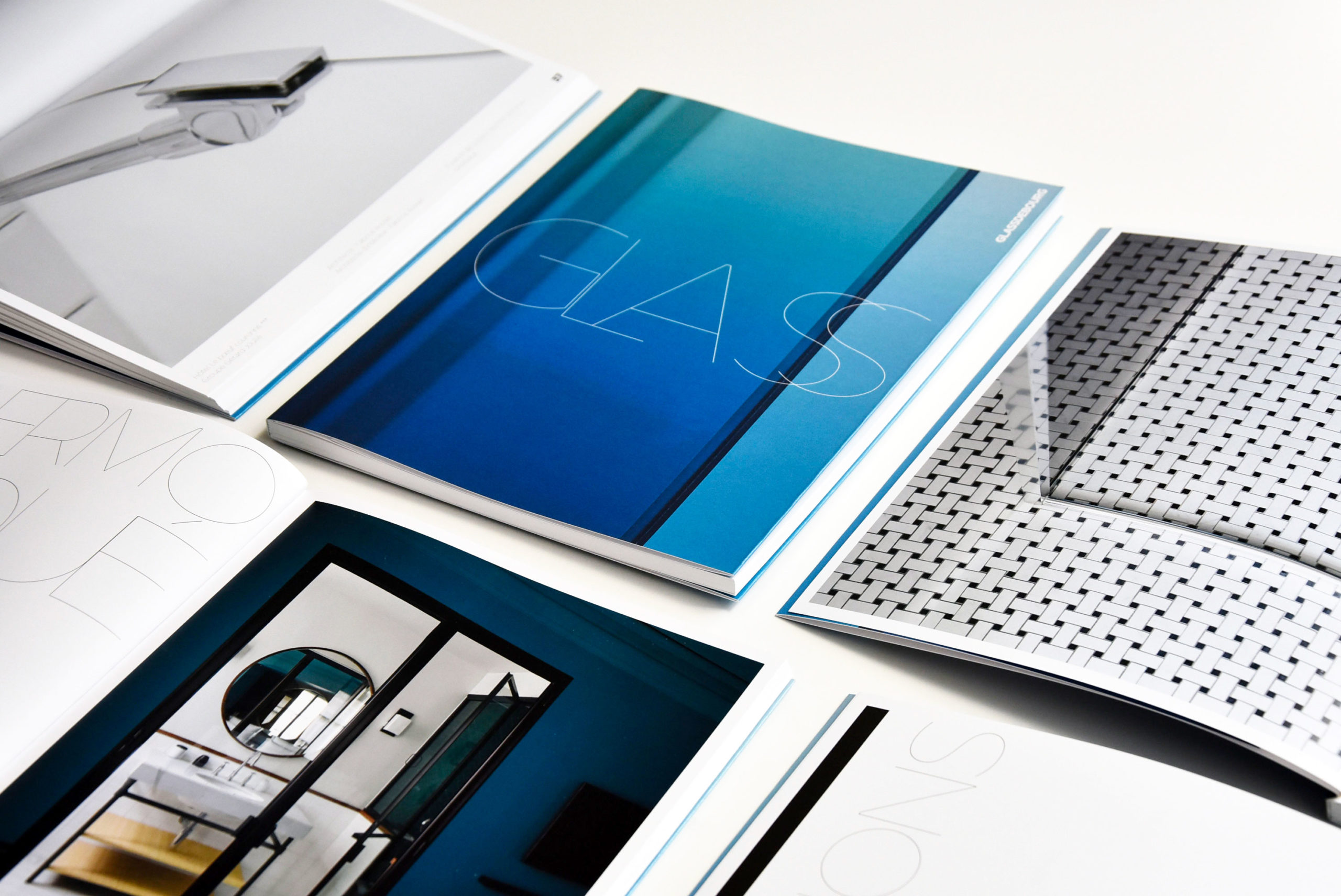
Why did you photograph the hardware store?
Any glass installation is enhanced by the metal: it provides structure, fixing and gives the whole thing a sparkle. In a way, without the metal the glass does not exist. After discussions with the client we decided to do a specific photographic work around the hardware. We approached these massive pieces as if they were photos of jewelry. Playing with reflective backgrounds, we designed each image with a graphic and minimal scenography. A simple hinge or hook was transformed into a piece of art.
Throughout the project we worked closely with photographer Fabrice Fouillet. Thanks to his rich experience in still life photography and his current specialization in architecture, we were able to approach the subject in perfect coherence.
The cover of the brochure is very specific. What was your approach?
For the cover we wanted to convey the feeling of glass – cold and sharp. The iridescent paper on the cover is again reminiscent of the reflection of glass. In the line of this idea, we designed the typography taking up these characteristics of glass. Thin, sharp and designed, it stands out on the blue background of the cover.
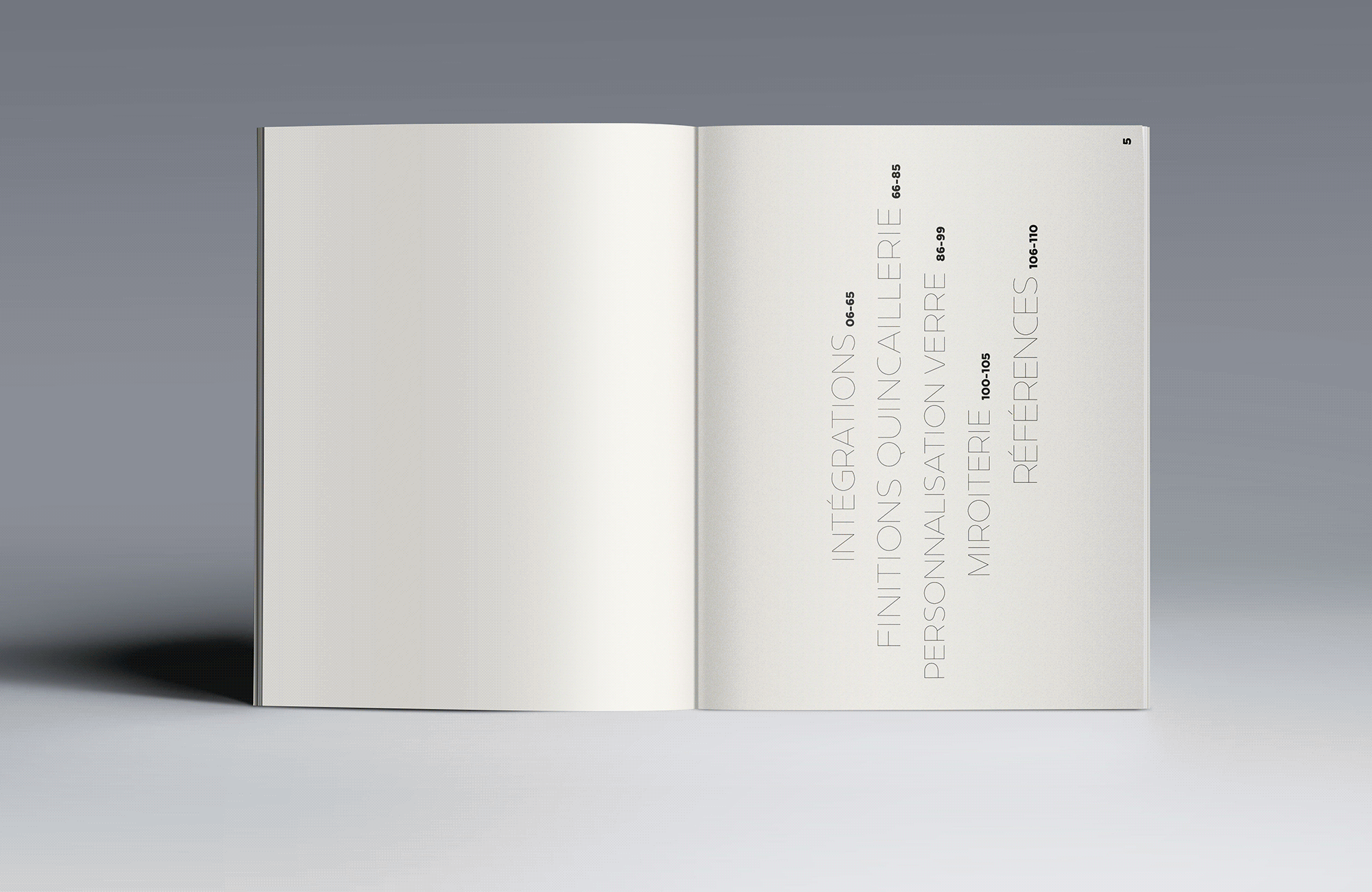
Discover the whole project here



















